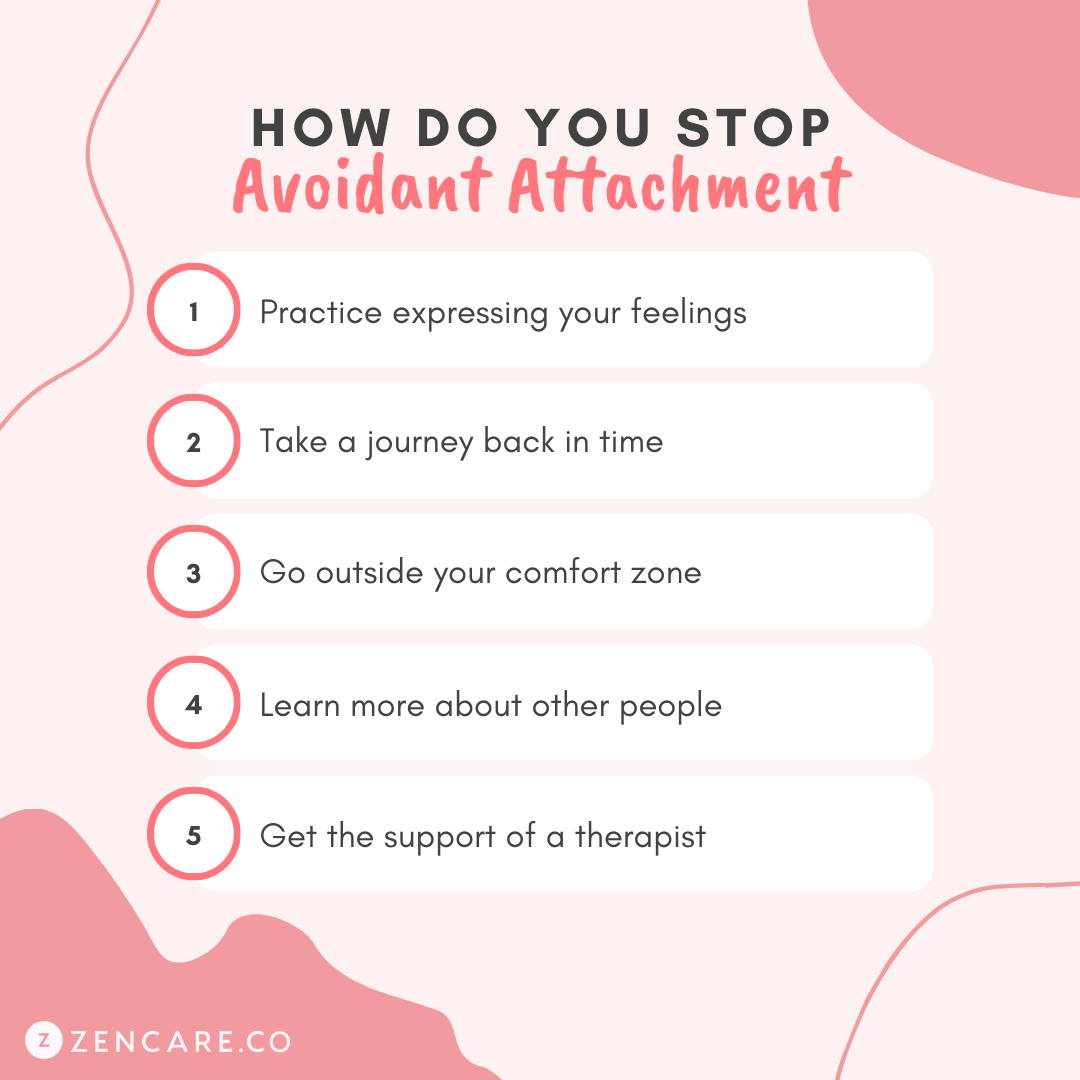Introduction
Attachment styles, deeply ingrained in our early experiences with caregivers, shape our intimate relationships. While secure attachment fosters closeness and comfort, avoidant attachment stands as a barrier to deep emotional connections. Understanding and addressing avoidant attachment is essential for those who yearn for fulfilling relationships. This comprehensive guide will unravel the complexities of avoidant attachment, and equip you with transformative strategies to mend its lingering effects.

Image: blog.zencare.co
Comprehending Avoidant Attachment: A Protective Armor
Individuals with avoidant attachment cope with perceived threats to their autonomy and emotional safety by minimizing intimacy. They maintain a guarded distance, fearing vulnerability and the potential for rejection. While this defense mechanism shields them in childhood, it can become a stumbling block in adult relationships, preventing them from experiencing the depth and joy that human connections offer.
Manifestations of Avoidant Attachment in Relationships
Avoidant attachment often manifests as a persistent need for space, reluctance to commit or open up emotionally, and discomfort with physical affection. Partners of individuals with avoidant attachment may experience feelings of confusion or rejection, as efforts to build intimacy are met with a seemingly indifferent response. Patterns of emotional distance and difficulty regulating intense emotions further characterize this attachment style.
Embarking on a Transformational Journey: Addressing Avoidant Attachment
Healing avoidant attachment requires a courageous journey of self-awareness, acceptance, and transformative practices. Developing a deeper understanding of one’s attachment style and the childhood experiences that shaped it is the cornerstone of transformative change. Being gentle and compassionate towards oneself and others who exhibit these behaviors is paramount in nurturing growth.
1. Cultivating Self-Awareness: Unraveling the Enigmatic You
Embark on a journey of self-exploration to unravel the intricate tapestry of your inner world. Engage in introspection, journaling, or seek professional guidance to discern your attachment patterns, beliefs, and triggers. Recognize that your avoidant tendencies serve as a coping mechanism, rather than an inherent flaw. By delving into the depths of self-understanding, you gain invaluable insight and empowerment.
2. Acknowledging the Root Causes: A Journey to Your Heart’s Origins
Upon gaining clarity on your attachment style, delve into your past experiences, particularly your early interactions with caregivers. Explore how these formative relationships shaped your current beliefs about yourself and others. Understand that while the past may have influenced your attachment patterns, it does not have to define your future. With empathy and courage, explore the wounds of your heart, and embark on a transformative journey towards healing.
3. Nurturing Emotional Regulation: Mastering the Waves of Your Heart
Emotional regulation is a precious skill that empowers individuals to navigate the turbulent waves of emotions without being overwhelmed. Practice mindfulness techniques to cultivate awareness of your emotions. Learn and apply effective coping strategies to manage intense feelings in a constructive manner. Through dedication and self-compassion, you can cultivate emotional resilience and create a safe inner sanctuary within yourself.
4. Seeking Secure Relationships: Beacons of Love and Connection
Building and nurturing secure relationships is a transformative force in overcoming avoidant attachment. Surround yourself with individuals who respect your boundaries, provide consistent support, and encourage your growth. Through these connections, you experience the healing balm of acceptance and love, gradually shedding the weight of past experiences and fostering a sense of belonging. Carefully choose your relationships and embrace the potential for profound healing and personal transformation.
5. Embracing Vulnerability: The Courageous Path to Authenticity
Vulnerability is the birthplace of intimacy and deep human connection. Gradually challenge your discomfort with vulnerability by taking small, manageable steps. Disclose personal thoughts and feelings with trusted individuals, allowing yourself to be seen and accepted as you truly are. Embrace the transformative power of vulnerability, recognizing that it is a sign of strength and resilience rather than weakness.
6. Therapeutic Guidance: Embarking on a Healing Journey with a Trusted Guide
Consider seeking guidance from a therapist who specializes in attachment issues. They can provide a safe and supportive environment for exploring and addressing the root causes of avoidant attachment. Therapy offers invaluable support, fostering self-empowerment, and facilitating transformative change. Together with your therapist, you can create a personalized healing plan tailored to your unique needs and challenges.
Conclusion: Unlocking the Gates of Intimacy through Healing Avoidant Attachment
Overcoming avoidant attachment is a journey of self-discovery and profound transformation. By understanding the intricate mechanisms of this attachment style, cultivating self-awareness, and embracing transformative practices, you can mend the wounds of the past and unlock the gates of intimacy. Remember, regardless of the challenges you face in your journey, kindness, patience, and perseverance are your steadfast companions. Step by step, you can forge a secure path towards fulfilling relationships, reclaiming your authentic self, and experiencing the boundless joy and connection that human hearts are capable of.

Image: helpfulprofessor.com
How To Fix Avoidant Attachment